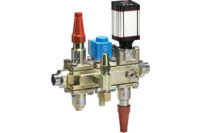It’s one thing to announce new refrigerants. It is another thing to figure out how they will work in real-life situations. With the industry facing an apparent shift to low global warming potential (GWP) refrigerants, the performance of those gases is being carefully studied.
At the most recent 15th International Refrigeration and Air Conditioning Conference at Purdue University (one of three concurrent conferences, the others dealing with compressors and high performance buildings), a number of researchers presented papers as part of an “Alternative Refrigerant Performance Comparisons” program.
Chillers
A familiar HFC is R-32 because it is used in a blend with HFC-125 to create R-410A. Now it is being looked at as a standalone refrigerant because it has a lower GWP than 410A.
In that context a paper was presented by Claudio Zilio on behalf of colleagues at Emerson Climate Technologies in Germany and the University of Padova in Italy. The title was “Energy Efficiency of a Chiller using R-410A or R-32.”
Among findings: “Basing on the proposed modeling work, it is possible to conclude that R-32 system efficiency performance is acceptable as an alternative to R-410A for water chillers.” At the same time the researchers noted they would continue to look at HFO refrigerants as well in regards to chillers.
Refrigeration
Gustavo Pottker acted as presenter for a group of engineers at Honeywell International Inc. who were looking as “Refrigerants with Low Environmental Impact for Refrigeration Applications.” They were looking at two refrigerants — one, N-40, is non-flammable and the other, HDR-110, is said to be mildly-flammable. The company also noted that the GWP of 110 is below 150 which will allow its use in certain applications under European Union f-gas regulations.
Part of the conclusion said, “The N-40 may be used in current refrigeration systems based on preliminary findings providing a great reduction of environmental impact. This is mainly due to reduction of GWP and significantly higher efficiencies. Both internal and external larger-scale lab evaluations were consistent in showing that N-40 has superior energy efficiency compared to (HFC-) 404A, with improvements between three and 11 percent.”
“Other options such as HDR-110 provide further reduction of GWP, and may be used in future self-contained systems capable of working with mildly flammable refrigerants. Experimental evaluations of HDR-110 conducted in R-404A reach-in freezer showed lower energy consumption and a near match in capacity. However, more work is needed to fully explore potential application of this refrigerant in such systems.”
HFO Aspect
A paper presented by Charles Janicki of Marquette University on behalf of that educational facility and Rexnold Corp. dealt with efforts to bring HFOs (one of which, 1234yf, is being used in automotive air conditioning) to stationary systems. The research was done with a room air conditioner designed to work with R-410A. The undergraduate students at Marquette reported the first step in the redesign process “was to develop a thermodynamic model of the existing RAC. The model was then modified to provide the same cooling capacity as the original unit using R-1234yf and a replacement compressor was selected based on the model results.”
Researchers then tried using 1234yf and 1234ze. Regarding the latter, the report said, “While the team was able to modify the RAC to operate with R-1234ze and was able to predict the unit’s performance with reasonable accuracy, the modifications required a significantly larger compressor and capillary tubes; therefore, the project clearly illustrated that fitting within the space and weight constraints of window units presents a significant challenge to implementing R-1234ze in RACs.”
Elevated Ambient
And what of all those low-GWP refrigerants that might need to be used in high ambient situations? That was one of the tasks tackled by Kenneth Schultz of Ingersoll Rand. He used a 15.5kW air-cooled water chiller/heat pump for testing a number of refrigerants, some with a system with R-410A like pressures and some with R-22 like pressures.
Among the findings: R-32 “offers potential for increased capacity and efficiency compared to R-410A with high ambient characteristics similar to R-22. DR-5 (refrigerant) offers characteristics very similar to R-410A with somewhat elevated compressor discharge temperature that did not exceed the limit until reaching 122°F for the equipment tested. L-20 (refrigerant) has characteristics very similar to R-22. Compressor discharge temperatures are only slightly elevated possibly being an issue in the equipment tested as air temperature approaches 122°.”
Evaporative Cooling
A paper titled “Experimental Performance Investigation of New Low-GWP refrigerants for Use in Two-Phase Evaporative Cooling of Electronics” was presented by Alexis Nicolette-Baker on behalf of her and her research colleagues at Parker Hannifin Corp.
“This study investigated four potential refrigerants…R-1234yf, R-1234ze, N-13a (HDR-17), and N-13b (HDR-15).” R-134a was used as a benchmark. “Each of these refrigerants was experimentally examined and compared to R-134a in a two-phase pumped loop cooling system using a specifically designed test stand. This test stand included a liquid pump, an evaporator with a heating component, and an air-cooled condenser.”
“The results indicated that R-134a had the best performance in terms of its required volume flow rate for a given heat load as well as its overall heat transfer coefficient and two-phase pressure drop at a given mass flow rate. While the former characteristic is important for pump sizing, the latter can have significant impact on the overall thermal resistance.
“With an average volume flow rate increase of eight percent, N-13b exhibited the best performance in terms of flow rate when compared to R-134a. R-1234yf closely matched the heat transfer coefficient values of R-134a. R-1234yf also showed 39 percent higher two-phase pressure drop which was better than the other candidates.”










